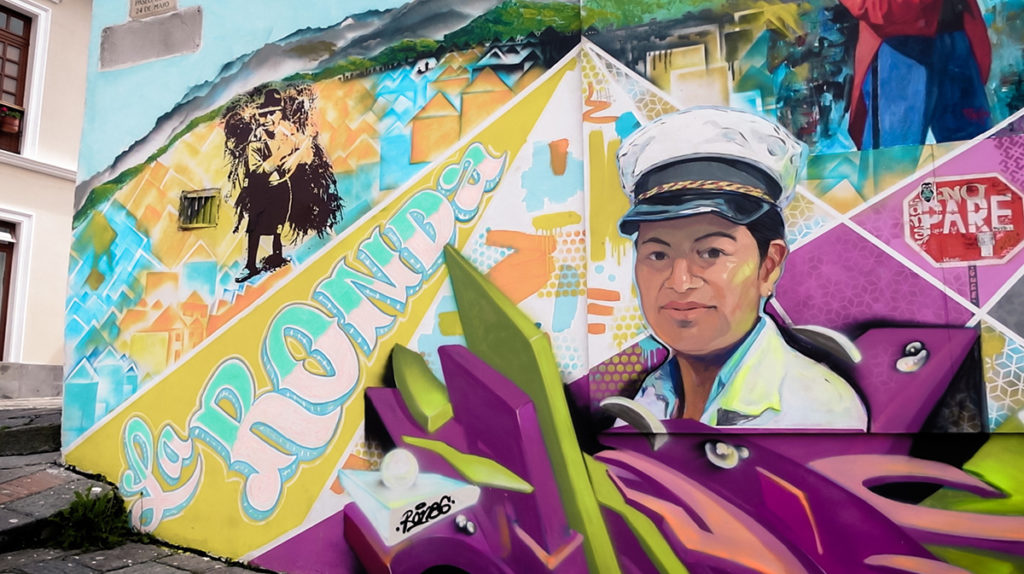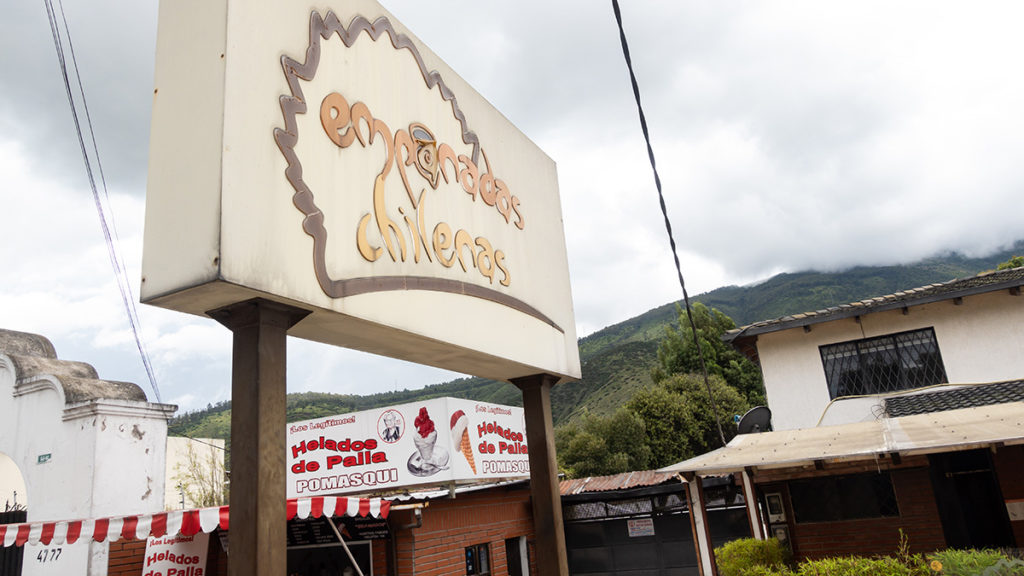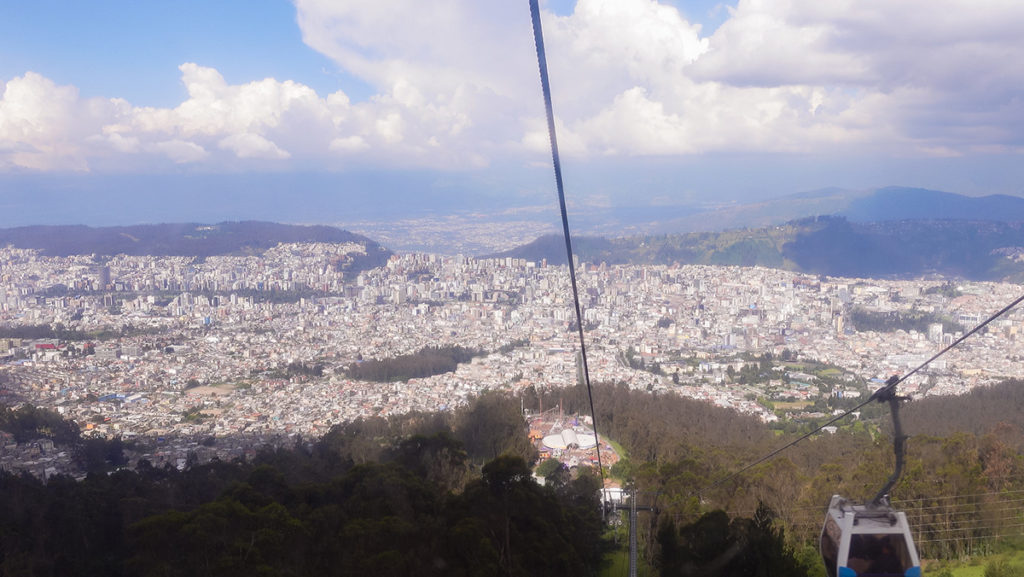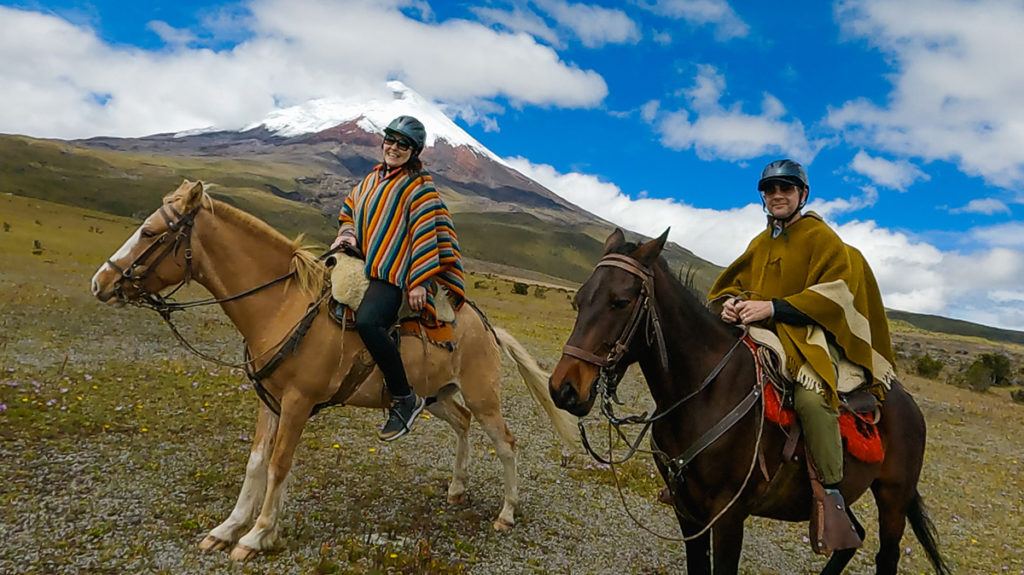If you’re planning a trip to Quito, Ecuador, congratulations – you’re in for an amazing experience! We assume you’re reading this post because you’re fleshing out that Quito itinerary, and we’re here to help.
Quito is an absolute gem. Not only is it one of the first UNESCO World Heritage Sites, it even earned its own spot as UNESCO’s first Cultural Heritage of Humanity. This capital city with million dollar views has a rich culture and history and is packed with awe-inspiring architecture. Unfortunately, too many people’s South America travel itineraries only include Quito as a stopover en route to the Galapagos. The aforementioned are just a few of the many reasons why Quito deserves its own itinerary.
Our first-ever international trip together was to Quito, back in 2011. Eleven years later, it’s where we began filming our first international series for our Youtube channel. This time, we spent two weeks in Ecuador, including Quito (plus some must-do day trips we’ll get to below), the Amazon, and one of our top-3 bucket list destinations: the Galapagos Islands!
We booked this trip with a Quito-based travel agent that focuses on sustainable travel – Terra Sur Travels. We know – “who still uses a travel agent?” Well, read this post for one surprising reason you should consider it, too – but I digress. About a year prior, before we were even considering traveling to Ecuador again, we discovered them and became friends on Instagram. Months later, when a killer flight deal to Quito popped up on FareDrop, we reached out to Terra Sur and they put together an awesome package for us within our budget. Major shout out and thanks to Angelica and Christian at Terra Sur for some mind-blowing recs we probably wouldn’t have known about otherwise!
So, with a couple of Quito visits under our belts now, let’s dig into the 7 essential things we think you should add to your own Quito itinerary.
1. Stay At a Locally Owned Hotel

There are plenty of options for where to stay when you visit Quito. You can find something in every price point, from luxury to budget. We found that among the wide variety of accommodations, Quito has an especially abundant amount of affordable boutique hotels and hostels. Our preference is to support smaller, locally-owned businesses as much as possible when we travel, and a cozy B&B is one of our favorite types of stays.
Why We Loved Casa Aliso Hotel
Casa Aliso is in the hip neighborhood of La Floresta, which is walking distance from the Old Town and a short taxi or rideshare from all of Quito’s most popular tourist attractions. Built in 1936, this beautiful house-turned-B&B has a wonderfully hospitable staff as well as a fantastic homemade breakfast that comes included with your reservation – not to mention a beautiful secluded outdoor space that many of the rooms have patio access to. And, you’ll find many restaurant options just steps away, literally in every direction.
2. Visit the Virgin of El Panecillo

If you’ve seen any photos or videos of Quito, surely you’ve seen the Virgin of El Panecillo, a.k.a. The Virgin of Quito. The monument stands 135 ft. tall on top of the small round hill that has been described as a “little loaf of bread.” Wearing a crown of stars, the winged Virgin is standing on a serpent and a globe and is said to be watching over and protecting the city. And those “million dollar views” we mentioned – this is one of them! The city is gorgeous from this vantage point. It is located between southern and central Quito in the Old Town, and no Quito itinerary would be complete without including a visit to this most iconic part of the city.
3. Explore Old Town Quito
When you come down from El Panecillo, be sure to spend time exploring Old Town up close and personal. Quito’s historic district is known for its charming narrow streets, markets, stunning Spanish Colonial architecture, historic attractions, and you’ll even find the presidential palace there. Things you should see in Old Town:
La Ronda

Located close to the base of El Panecillo, Calle La Ronda is one of the oldest streets in Quito with a storied history. The street is narrow and charming, lined with many small shops selling handmade crafts and typical Ecuadorian snacks. Hot tip: get the roasted peanuts with sesame seeds. I know it sounds plain, but the brown sugar they mix them in (right in front of you!) puts it over the top!
Check Out the Urban Street Art

There are some beautiful murals in Old Town that give a colorful look at Quito’s colorful history. Many images depict traditional people from the streets who rose to popularity for their unique skills. If you have the opportunity to have a private tour guide like we did, go for it – it will give a much deeper understanding of what the art represents.
Basilica Del Voto Nacional
Quito has to have more churches than any other city we’ve visited. You’ll see proof of this as you explore, and especially from just about any of the views that overlook the city. These are best observed up close, if even only from outside. Basilica Del Voto Nacional’s neo-gothic architecture features “gargoyles” like no other church: animals that represent Ecuadorian wildlife, like turtles, birds, caiman, and more. How unique is that? We would have never noticed this cool detail if not pointed out to us.
Monastario Museo del Carmen Alto
With a long, long history, it is still home to cloistered Carmelite nuns who produce some of Quito’s tastiest sweets, baked goods, aromatic waters, and a liqueur called Mistelo, just to name a few. Back in the day, they were primarily known for the wine they produced. Traditionally, since the nuns weren’t allowed to be seen by the public, they made all of their transactions through a “lazy-Susan” type of window. That window still remains today, and there is also now a museum on site where you can purchase the goods we mentioned above.
Basilica and Convent of San Francisco

From what we understand, this is the oldest and most significant religious site in Ecuador. Also referred to as “el San Francisco,” the church, convent, and equally as historic large square are all situated right in the middle of the historic center of Quito. And hey, remember those million dollar views? Pay the extra few bucks to climb the stairs to the top of the basilica to take in another fantastic one. And on your way out of the square, if you see a little wooden rocking horse, find the person minding it and get your photo taken on it! Apparently, it’s an old-school (and fading) tradition for kids to have their photos taken on it. So hop on and help keep the tradition alive – you’re already beyond the point of regretting it in later years, like all those kids.
4. Lunch – What to Eat in Quito
Just about any kind of food you might be looking for can be found in Quito. Anything from sushi to pizza and everything in between is waiting for you. It might take a little deeper digging to find a lot of Ecuadorian-specific foods vs. an overall mix of South American and Latin American influenced dishes. Such as these two recs we have for you on that front: empanadas and ceviche. In particular, these two spots, which were both recommended by locals.
Empanadas Chilenas

This walk-up counter service restaurant was suggested by our private tour guide, Fausto, and it more than lived up to his praise. We tried looking it up to get the specific location, but the name is so generic that it’s hard to find definitive information for you. But we do know it’s on the way to the equator and you can’t miss it – watch for the sign on your left!

These empanadas are substantial in size, and have a bit of a crispy fried texture on the outside. We’re vegetarian (pescatarian when we travel), so we went with the veg option, while Fausto ordered chicken. They are simply fantastic, as is the sauce/salsa that came on the side! They even made a nice espresso, which we capped the meal off with. We highly recommend this place.
Ceviches de Guápulo

This next spot seems to be (or at least, was) Quito’s most well-known best kept secret. Is that a thing? Andie’s parents lived there for a few years, which is what led to our first visit back in 2011. They were tipped off to this place by some locals that they’d gotten acquainted with, so it was the restaurant they’d most looked forward to bringing us to. We didn’t have the chance to go back during our visit this year but Andie’s folks did when they visited a couple weeks before us. To this day, eleven years later, it is still hands-down the best ceviche we have ever had! I’m a little unsure how to better put my finger on what exactly is so good about it, but it’s super fresh and flavorful, and the popcorn (yes, popcorn!) is a nice touch. It’s a beautiful restaurant that leaves you feeling like you’re in someone’s home, and has an awesome outdoor dining space. Their hours and availability are limited, but if you can get there, go – you won’t be disappointed.
5. Visit the Equator(s) – Both of Them!
Wait. Two equators? Well, yes, sort of. You may have seen photos of people standing on either side of a painted yellow line on the ground, with a large stone monument behind them (just like us!). This is Mitad del Mundo, or “half the world. For many years this was believed to be the location of the equator. In more recent years, thanks to gps, it came to be known that the original location was actually incorrect. The true equator is about 200 meters away. So, the first location is merely a cute photo-op at a nice landmark that is close to, but not actually the equator. Still, it’s very pretty there and you should check it out, and get that photo – like this!

The true equator is located at Museo de Sitio Initiñan, or “Initiñan Site Museum.” For just a few bucks, you can have a guided tour (in English or Spanish) of the handful of exhibits that focus on the native tribes of Ecuador. There are replicas of typical, very small houses, live guinea pigs, a giant taxidermied anaconda(!) and a burial mound where the guide will explain some of the former rituals of death for the Tsachila people.

Other fun activities and things to see there include a sundial, walking the equatorial line with your eyes closed, balancing an egg in the head of a nail, and a demonstration of the Coriolis Effect — basically, pouring water into a sink and watching it drain clockwise while on one side of the equator, and then counterclockwise when it’s moved to the other side. It’s definitely worth including in any Quito itinerary, if not only to get that photo at the actual equator, and it’s especially fun for kids.
6. Get the Best View of Quito at TeleferiQo!

Your Quito itinerary should definitely include as many views of the city as possible. Here, you will ride one of the world’s highest aerial lifts (about 10-20 minutes) up along the east side of Pichincha Volcano to the top of Cruz Loma. The sprawling views of Quito get better and better the higher you climb, and you’ll get to see them again on your way back down – weather and cloud cover permitting, of course. TeleferiQo is a tourist attraction as well as the starting point for hiking to the summit of Pichincha. This 2.5 mile hike is not for the faint of heart. Do your research, be realistic about any health limitations you may have, and prepare accordingly before attempting this.
Once at TeleferiQo, you can enjoy many photo-ops and observation points, and kick back in the cafe with a snack, coffee (yes, please!), and breathtaking views of the city. There are also a few shops in the complex, restrooms, and if you’re not too out of breath to hike just a little bit higher (a little bit too much more for us on that day), you can ride the swing into the clouds at 11,000 feet for the uber-grammable photo!
Be prepared to wait in line for the gondolas, both on your way up and when you return back down. As a point of reference, we were there on a Sunday in mid-May and our waits were about an hour each way. The good news is you’re not limited to a specific amount of time at the top. Hang out as long as you like and just jump in line to ride back down whenever you’re ready. So, it’s very tourist attraction-y in that way, but it’s totally worth it for the ultimate million dollar views of Quito.
And since Quito is at a high elevation, and TeleferiQo even higher, you might find this post helpful: How to Prepare for High Altitude Travel.
7. Add A Day Trip To Your Quito Itinerary
There are many incredible day trips that you can take from Quito, and most are within just a couple-few hours away by bus. Here are a few that we recommend for any Quito itinerary:
Cotopaxi National Park

Cotopaxi is the second-highest (active!) volcano in Ecuador at over 19,300 feet, and the centerpiece of Cotopaxi National Park. Not only was this our favorite day trip from Quito, but it turned out to be among our top three highlights of our entire 2022 Ecuador trip – right up there with the incomparable Galapagos Islands and Amazon Rainforest! Our travel agent gave us three options to choose from: hiking, mountain biking, or horsebacking. We chose horseback, mostly because we knew we’d be pretty hiked-out from the previous day in Mindo. As luck would have it, everyone else in our group chose hiking or biking. So with just us, our guide, and three horses, we felt like we had Cotopaxi all to ourselves. Three hours exploring the expansive base surrounding the volcano. Sunshine, rain, hail, thunder, lightning, various terrains, spotting loads of animal bones and a lone wild horse. It was a magical, unforgettable day! Check it out for yourself in our vlog: Cotopaxi National Park | Volcano Day Trip From Quito. Here’s a great horseback riding and Cotopaxi National Park day tour with hotel pickup, boxed lunch, and traditional drink at a local hacienda included.
Mindo

A day trip to Mindo is a must for any Quito itinerary. Escape the city for a day and immerse yourself in this gorgeous protected cloud forest reserve. There’s so much you can do here – from super-chill to highly active. Stroll the village and explore shops, taste locally made chocolate and coffee, and you can even learn how both are made. You can visit a butterfly farm and if you’re into birds, boy, is Mindo the place for you! Hot tip: there’s a fantastic bird sanctuary a short while outside of Mindo called San Tadeo Birding that we highly, highly recommend. You’ll pass it on your way up to Mindo, and it’s worth a stop if you’re able. As for the more adventurous activities in the cloud forest, they’re off the charts. Ride an open gondola above the canopy to begin an amazing (and tough) hike to multiple magnificent waterfalls, go river tubing, or our fave – zip lining through the canopy! You can choose packages of three, seven, or ten zip lines, with each launching platform being higher than the previous. This also means progressively more difficult “little” hikes between each ride. It’s truly awesome, and we can’t recommend it enough, but phew! Here’s a great small group full day tour from Quito to Mindo that includes just about everything we mentioned above – and lunch at a local restaurant We’ve got a Mindo vlog, too – check out Zip Lining and Hiking In the Cloud Forest.!
Otavalo
Also a couple of hours from Quito is Otavalo Ecuador Market. This is the largest marketplace in Ecuador, and one of the largest in Latin America. If you’re looking for quality locally-handmade crafts and goods, this is the place for you. In particular, the local artisans are known for their intricate weaving skills. You’ll find bracelets, Panama hats, hammocks, wooden carvings, and even silver jewelry. The shops are full of beautiful colors, as rich as the culture and traditions of Ecuador. And don’t forget to hit up those food stalls to try some local delicacies. Shopping does work up an appetite, after all! The marketplace is open every day, but Saturday is by far the biggest day of the week. Sure, the crowds are bigger, but there’s also a much larger selection of goods to choose from. If you’re feeling like navigating one of South America’s largest markets might be a little overwhelming, consider this private full day tour to Otavalo (and surroundings).
Quilotoa Crater Lake
Quilotoa crater lake is perhaps one of Ecuador’s best kept secrets. Laguna Quilotoa is actually a collapsed volcano, also known as a caldera lake. It is famous not only for its beautiful blue-green colored water, but its proportions: almost two miles wide, with its walls reaching over 1300 feet from the surface of the water up to the viewpoint area, and the depth of the water itself is around 800 feet. The panoramic views at Quilotoa are jaw-dropping, and if gazing down at the water from the viewpoint isn’t magnificent enough, you can also get close up with some kayaking. Various hiking opportunities are available, such as the popular “down-and-back” (from the viewpoint down to the water), a rim hike, and the multi-day Quilotoa Loop hike. You’ll also see plenty of people mule riding while you hike, and if you prefer, that’s also an option. As for whether swimming is allowed or not, we suggest you do your own due diligence. To the best of our knowledge, swimming is strictly prohibited and dangerous. Drastic drops in water depth, extremely cold water temperatures, and unhealthy exposure to volcanic minerals are just a few reasons that are sighted. That said, we don’t feel this is a negative in the slightest, as the views alone are more than worth a visit. Here’s a private day trip from Quito to Quilotoa Crater Lake that includes hotel transport, a village lunch, and a visit to an indigenous market.
Baños
Baños is another very popular day trip from Quito, and is primarily known for its natural thermal baths (as its full name “Baños de Agua Santa” references) and loads of adventure sports. Unfortunately we weren’t able to fit this one into our itinerary, but we did do our research in advance of our last trip to Ecuador. One of the first things-to-do that you’ll find is the famous swing on the “tree at the end of the world.” This is at Casa De Arbol and it’s one of the most popular reasons that people head to Baños – to get that iconic shot for the ‘gram, high above the world. But before that, you’ll pass multiple stunning waterfalls as you make your way through the valley of Baños. If you’re looking for handicrafts and artisanal souvenirs, there is plenty of shopping to be had. The same goes for local eats! The mercado in Baños (like most in South America) has a great variety of fresh, local, and inexpensive options to feed your face with, or simply graze on street food as you make your way around town. Some of the more adventurous activities you can get into in Baños include white water rafting on Rio Pastaza, zip lining through the trees, and something we’ve yet to try – canyoning! You can unwind with massages and spa treatments, and whatever you do, don’t skip out on visiting the thermal baths – it’s what the place is named for, after all! Looking for private transport from Quito to Baños, or Baños to Quito? Click that link to skip the stress and tedium of public transport and its many stops.
Of course, this is only a sampling of some of the amazing things to do and see in and around Quito, but they’re also our firsthand experiences, which makes us feel confident that we’re steering you in the right direction. Which has you most intrigued? What would you add to the list? Drop a comment below to let us know, and happy travels!
And before you start flexing that credit card and booking your trip, we think it’s a good idea for you to give this a quick read as well: Why You Should Consider Using a Locally-Based Travel Agent
